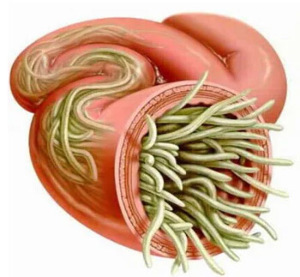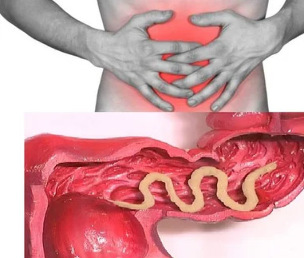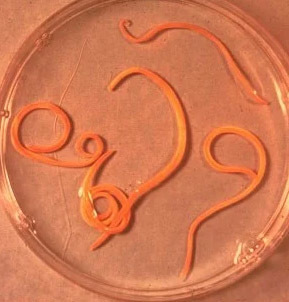To date, science knows about 280 species of worms that can grow and live in the human body parasites in various organs and tissues. The frequency of infection with worms of a person hell of climatic and socio-economic conditions of specific areas (in less developed countries, especially those located in tropical and subtropical area, the level of parasitic infections is much higher than in economically developed countries).
The ways of human infection with helminths:
- Bioelements (infection of ad animals).
- Contagious lesson (which translates hell of a person so person).
- Geohelminths (a disease caused by parasites that spend one of the life cycles on earth).

Factors that affect the manifestations of helminthiasis
App of penetration of the parasite into the body:
- The degree of adaptation of helminths and the human body;
- Population density (number) of parasitic specimens;
- The habitat of the worm (tissue parasites live in the thick soft tissue and luminal live in the Lumina of hollow organs). Some helminths in different phases have both luminal and tissue forms. And developing larval stages of worms, as a rule, causes more severe pathological changes.
In the absence of re-infection the number of adult parasites in the human body is not increased. This feature distinguishes helminth infection ad disease caused by bacteria, viruses, fungi and protozoa organisms.
Worms in humans: symptoms
Helminthiasis is a disease that is characterized by a 2 phase flow (sharp, hell two weeks and two months) and chronic (hell a few months and several years).
Symptoms of the acute phase of helminth infections
The first signs of the disease may occur at different times (often 2-3 weeks, ascariasis – after 2-3 days, and when filariose the incubation period can last 6-18 months).
In the acute phase of parasitic infestation the most common symptom of the phenomenon is an allergic reaction (is the development of antibodies to the antigens of the migrating larvae of parasites). Often, people infected with worms on the skin are itchy rash, prone and recurrent course, increasing the regional lymph nodes, may cause generalized or local edema, muscle and joint pain. Migrating larvae of the parasite can cause pains in the chest, cough, asthma, disorders stool, nausea and vomiting.
In the acute phase of helminth infections may be accompanied by more serious eznim disorders (a severe form of pneumonia, hepatitis, allergic myocarditis, hepatosplenomegaly (enlarged liver and spleen).
In the blood increases the number of eosinophils (eosinophilia) and interferes with the normal quantitative relationship between protein fractions (dysproteinemia).

Signs of chronic helminthiasis
Symptoms of chronic phase depends hell what a body "inhabited" by the parasites, and also play an important role as their size and number.
So, when the parasite in the intestine of single individuals, the disease may be asymptomatic (with the exception of cases of very large parasites). The characteristic features of the chronic phase of intestinal helminths phenomena are dyspepsia. Children have largely expressed asthenoneurotic and pain. With a massive infestation by Ascaris may develop intestinal obstruction, obstructive jaundice and pancreatitis.
Consuming all the essential for the activity of the substances from the host organism, the worms cause digestive disorders, malabsorption of vitamins, minerals, carbohydrates, proteins and fats. At the same time the waste products of the worms inhibit the normal intestinal flora and lower the immune power of the body.
People suffering from helminthiasis, due to a weakened immune system, and enhanced the cell division process (a result of a permanent recovery of damaged tissue parasites) significantly increases the risk of malignant tumors.
The types of worms that are parasitic in the human body
The causative agents of human helminthiasis are 2 types of worms: round (nematodes) and flat (tapeworms and flukes).
Roundworms
Pinworm
Parasites, what events cause antirabies is small (Yes 10mm) thin abdominal worms, which have a grayish-white color. Infection occurs through the alimentary (through the mouth). The reason is dirty hands. The eggs of the parasite can remain in the ground, on the fleece of infected animals, unwashed fruits and vegetables, etc. however, when enterobiasis cases of samsarajade (especially in children), which arise as a result of scratching the itchy areas and subsequent ingestion of eggs. Pinworm larva develops within two weeks in the digestive tract. Turning into an adult worm parasite in the lower thin and upper parts of the colon.

Ascaris
Ascaris is a parasite of large fusiform red-yellow colour that reaches an adult of 40 cm (females) and 15-25 cm (males). Not having suction cups or other devices are attached, the worm is able to move food towards the masses. Eggs laid by the female parasite are excreted with the feces.
Infection with ascariasis occurs in case of ingestion of the Mature eggs with the water, or unwashed fruits and vegetables that contain soil particles. After penetration of eggs in the intestine have Mature larvae. Then, taking root in the scene of the bowel they bleeding reaches the heart, and thence into the lungs. Through the pulmonary alveoli roundworm larvae through the respiratory tract enters again into the oral cavity. After re-swallowing the parasite reaches the small intestine, where they develop into an adult. The worm lives in a period of 12 months, Dalia dies and is excreted together with feces. In the intestine of one host can live as one, and several hundred individuals.
Whipworm
Whipworm, which causes trichuriasis is white worms, which are parasitic in the initial section of the large intestine and reaches the size of 4-5 cm in the parasite Feeds on the blood and tissues of the mucous membrane of the rectum.
Whipworm eggs laid by the female in the scenes of the intestine, come out with feces. Their development occurs in the environment (optimally in the soil). Eggs with green in them larvae of the parasite enter the body through the alimentary, through dirty hands, water or unwashed vegetables and fruits.

Trichinella
The causative agent of trichinosis are small round worms, which can reach 2-5 mm in length. Infection occurs by eating undercooked meat (pork, bear meat, boar or). Penetrating in the intestine, the larvae of the parasite within 3-4 days to Mature and condition of the Mature individuals. The lifespan of the worm is 40 Zen, after which the parasite dies. Prosurvival intestinal scene, the larvae penetrate into blood and are carried to all organs of the human body, settling in the muscles. In this case, most often affects the respiratory and facial muscles, and muscles of the limbs.
In the first days after the invasion, patients complain of abdominal pain. Then, after about 2 weeks, the body temperature rises 39-40 Yes With the skin are itchy rashes develop muscle pain, swollen face. In this period, in the case of a massive infection, there is a significant risk of death. After about a month of recovery occurs. The parasite is encapsulated in a spiral shape, after which for two years dies.
Ancylostoma and necator
These two parasite similar biological characteristics, and caused by diseases. With this regard, they decided to merge under the common name (hookworm). Worms that reach a length of 10-15 mm, parasitic in the 12th. intestine. It is worth noting that this is one of the most common, but, at the same hour, and rarely occur parasites. Larvae of the worms penetrate the human body through the skin by contact with infected soil. Dalia gets in the bloodstream, they, as well as roundworm migrate to the lungs and through the bronchi along with otharkivajushche phlegm in the digestive tract. Ancylostoma parasite in the intestine, attaching itself to the intestinal wall, Yes. Parasite that feed exclusively on blood, piercing bite through mucous membrane blood vessels, injecting anti-coagulant component there. During the day, an adult on average can absorb of 0.05-0.35 ml of blood. Therefore, the most characteristic symptom of this bot phenomenon is iron deficiency anemia, and changing the ratio of protein fractions (dysproteinemia).
Flat worms
A tapeworm
This is one of the largest worms, which reach a length of 10-20 meters. The disease caused by this parasite, called difillobotrioz. The developmental cycle of the worm starts with freshwater fish or crayfish. In the human body, the phenomenon is the definitive host of the broad tapeworm, larva gets together with caviar or infected fish fillet. Reaching the small intestine, the parasite attaches itself yeah its walls and within 20-25 Zen grows Yes Mature individuals.
Liver Fluke
The parasite that causes opisthorchiasis is a flat worm that reaches a length of 7-20 mm. it Should be noted that more than 50% of cases of infection of liver Fluke (also called cat Fluke) affects the inhabitants of Russia. The parasite larvae begin to develop after contact with eggs in fresh water (from swallowing them snails). The distance they penetrate into the body of the fish (carp, crucian carp, bream, roach). Human infection occurs by eating infected fish hedgehog meat which has not passed sufficient heat treatment. The larva of liver Fluke from the small intestine penetrate into the biliary ducts and gall bladder, fixing it with the help of two suction cups.
Bovine and pork tapeworm
These are almost identical in structure, the parasites reach a length of 5-6 meters. Infection with beef tapeworm infection and teniasis is due to eating beef or pork infected with the Finns (one of the intermediate forms of helminthiasis). Viable Finns presented in the form of whitish bubbles that reach the size of 0.5 cm, and attached to the walls of the small intestine of man and for 3 months turns into an adult. Band parasite that consists of more than 2000 segments, is constantly growing. However, the end segments, which contain eggs, break off and move independently through the colon and anus, and then crawl out of the anus, or stand out in the environment along with faeces. The most typical symptoms of helminthiasis phenomenon is the disruption of the digestive tract.
Echinococcus
For this parasite a person has eaten is the intermediate host. The worm is parasitic in the human body in the form of Finns. The final host of Echinococcus – the wolf, the dog or cat. Infection occurs through the alimentary in contact with animals and with objects of the environment, contamination of eggs of Echinococcus. After entering the intestine, of which developing oncospheres (larvae shestigrannye). From the intestine they enter the bloodstream and spread throughout the body.
Alveolar
This parasite, which is considered a type of tapeworm, the phenomenon is the cause of one of the most dangerous helminth infections (of alveococcosis), which according to the severity of the passage is similar to cirrhosis and liver cancer. Infection occurs by the penetration of oncospheres (eggs with green larvae) in the intestines. There the embryo emerges from the egg, and, penetrating into the intestinal wall, enters the bloodstream. Dalia, the bloodstream parasite is distributed to all tissues and organs of the body (most often localized in the liver). It was there in the larvae starts on the main stage (formed of the multi-bubble, labrocyte). Each cell contains the embryonic head of the parasite, which continues to develop gradually. Eurocity is a very aggressive formation, increasing due to the bubbles increase, and also have the ability to grow in the liver, like cancer metastases.
Diagnostics of helminthiasis
Diagnosis of worm infestation includes the following activities:
- careful gathering of the anamnesis, which helps identify possible causes of infection;
- laboratory testing of stool, blood, content, 12P colon, rectal and perianal mucus, muscle tissue, lung sputum, bile. The analysis can be discovered eggs, segments or fragments of parasites. However, increased blood levels of eosinophils are also of the phenomenon is the signal bot.
- in the diagnosis of diseases caused by larval stages or tissue parasites are serology (IFA, RSK, reaction of indirect agglutination, immunofluorescence, analysis, etc.).
- to identify the helminths that affect the liver tissue, is assigned to ultrasound, CT and endoscopic examinations.
Worms in humans treatment
In the acute phase of parasitic infection, the patient is prescribed detoxication and desensitizing therapy. In severe course of the disease (a trematode of the liver, trichinosis) medically used glucocorticoids.
As drugs specific therapy given the nature of the agent assigned to a special de-worming chemotherapeutic agents.
In parallel, the patient is recommended to take antihistamines and chelators. The final stage of the treatment involves using probiotics, normalizing the intestinal microflora.
Also appointed as special sparing diet (hedgehog needs to be legislatively and contain little fats).
In the period of antihelminthic therapy ad patient requires strict adherence to personal hygiene (to avoid reinfection). At the same hour in many helminth treatment to family members and persons kept in constant contact.






































